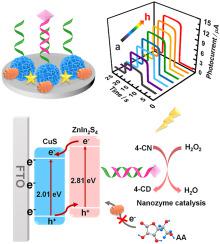Talanta ( IF 5.6 ) Pub Date : 2023-05-03 , DOI: 10.1016/j.talanta.2023.124631 Hong-Ying Yang 1 , Jing-Jing Wei 1 , Jia-Ying Zheng 1 , Qing-Ying Ai 1 , Ai-Jun Wang 1 , Jiu-Ju Feng 1

|
Vascular endothelial growth factor 165 (VEGF165) is a crucial regulator of angiogenesis and works as a major protein biomarker of cancer metastasis. Therefore, its quantitative detection is pivotal in clinic. In this work, CuS/ZnIn2S4 flower-like heterojunctions had strong and stable photocurrents, which behaved as photoactive material to construct a photoelectrochemical (PEC) aptasensor for detecting VEGF165, combined by home-prepared (MnCo)Fe2O4 nanozyme-mediated signal amplification. The interfacial photo-induced electron transfer mechanism was chiefly discussed by UV–vis diffuse reflectance spectroscopy in details. Specifically, the (MnCo)Fe2O4 modified VEGF165 aptamer was released from the PEC aptasensing platform for its highly specific affinity to target VEGF165, which terminated the color precipitation reaction, ultimately recovering the PEC signals. The developed sensor displayed a wider linear range from 1 × 10−2 to 1 × 104 pg mL−1 with a smaller limit of detection (LOD) of 0.1 fg mL−1. This study provides some valuable insights for building other ultrasensitive aptasensors for clinical assays of cancer biomarkers in practice.
中文翻译:

用于信号放大的 CuS/ZnIn2S4 花状异质结和 (MnCo)Fe2O4 纳米酶的整合及其在癌症生物标志物的超灵敏 PEC aptasensing 中的应用
血管内皮生长因子 165 (VEGF 165 ) 是血管生成的关键调节因子,是癌症转移的主要蛋白质生物标志物。因此,对其进行定量检测在临床上至关重要。在这项工作中,CuS/ZnIn 2 S 4花状异质结具有强而稳定的光电流,作为光敏材料构建光电化学(PEC)适体传感器检测VEGF 165,结合自制(MnCo)Fe 2 O 4纳米酶介导的信号放大。主要通过紫外-可见漫反射光谱详细讨论了界面光致电子转移机制。具体而言,(MnCo)Fe 2O 4修饰的VEGF 165适体从PEC适体传感平台释放出来,因为它对目标VEGF 165具有高度特异性的亲和力,终止了颜色沉淀反应,最终恢复了PEC信号。开发的传感器显示更宽的线性范围,从 1 × 10 −2到 1 × 10 4 pg mL −1,检测限 (LOD) 更小,为 0.1 fg mL −1。这项研究为在实践中构建其他用于癌症生物标志物临床检测的超灵敏适体传感器提供了一些有价值的见解。





















































 京公网安备 11010802027423号
京公网安备 11010802027423号